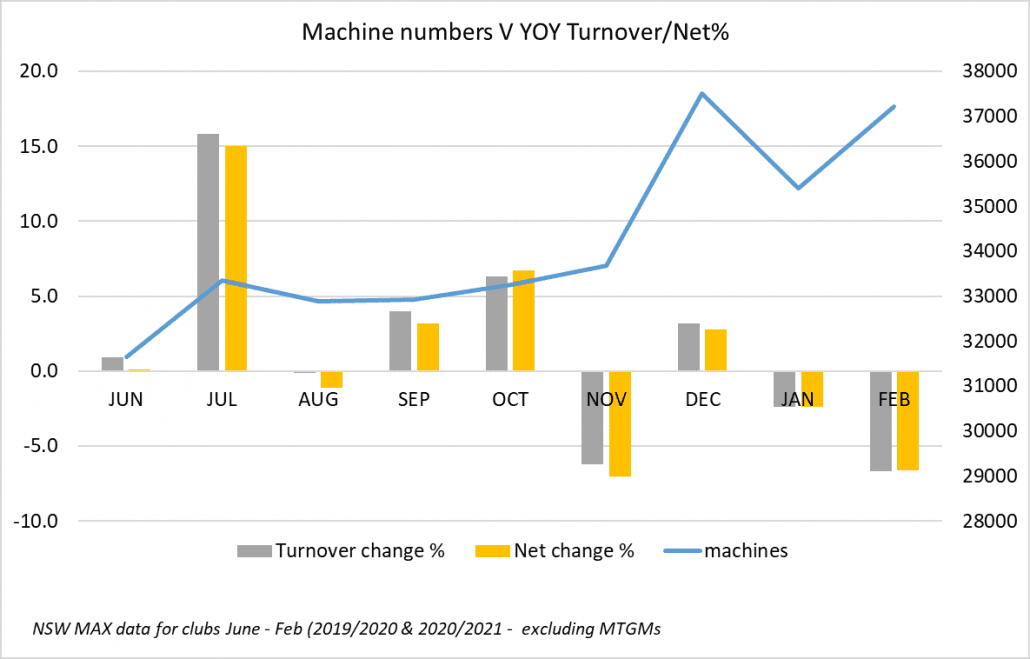Less machines and more space
In June 2020, when clubs started to reopen (in NSW) only 70% of the machines in the state were operational with one person per 4m2 restrictions in place. By February 2021 the number of operational machines has increased to 83% of the previous year’s pre-COVID levels. Despite this increase in machines, there has been no corresponding increase in turnover and net profit.
In the graph, the year-on-year percentage change for the months since post-COVID reopening is plotted in comparison to the number of machines in the market. After an initial increase in turnover and net in the early months after clubs in NSW reopened, results have been softening from November on as more machines have been reinstalled onto gaming floors.
So… what’s changed? How do you deal with it? What operational and cost impacts does it have on the gaming floor?

- Clubs had too many machines
The data certainly suggests that most clubs had too many machines on their gaming floor, which is not a new discussion for many venues. However, this argument is a little simplistic. In reality, the impact of machine restrictions has seen gaming managers become much more ruthless about what machines remain on their floor. Old machines are in storage in most clubs but even newer machines that are below average have been removed unless there are strong viable game conversions available.
The competition for space has increased not just among manufacturers but also among game types, with clubs increasing their link products where it is warranted and a large decline in the older high and mid denomination games.
- What is a “comfortable space” for a player?
It is also becoming clear, as clubs can now add the full complement of machines back in under released space restrictions, that the players prefer having the extra space. Customer comments are confirming that they feel more comfortable and much safer with no one sitting immediately next to them. Whether that feeling is fear of COVID-19 or just a privacy issue is debatable, and clubs will need to consider either increased privacy screening or increasing the distance between machines permanently where possible.
A straw-poll of your gaming players should quickly confirm how they feel about extra space between machines at your venue
- Are players having a better experience?
Most clubs have a large number of their games that barely crack $10K a month in turnover sitting on their floor. As clubs were seeing around the same turnover from less machines before November it can be assumed that the same amount of turnover going through less machines should statistically increase the win opportunity for players. For most this will just mean that their money now seems to last a little longer than it did before, but as “time” is what most of the players are looking for, this is a big positive.
- Cost Savings
All clubs learnt during the last year the value of appropriate costs savings. While the gaming floor has become even more important as the engine room of club revenue there are cost reductions that can be made by reducing machine numbers. If the per machine DMS fees, service fees, electricity and staff costs per month are greater than a machine whose turnover is so low it barely generates a few hundred dollars a month, then it’s better to remove it (or update it!)
As machines are returned to the gaming floor in clubs and hotels real consideration of the comfort and personal space for players needs to be addressed and new benches, privacy screens and machine spacing must become a part of future room renovations. Unless a venue is able to expand their gaming floor to accommodate this change, then the next best option is removing machines to allow for extra space. While that is traditionally counter-intuitive to many managers, it has significant cost benefits that should be investigated.
By Justine Channing – Cream Gaming & Strategy Specialist
© The Drop 2021 – Material may not be reproduced or distributed without the authors consent











